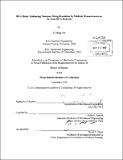DNA ruler : enhancing nanopore sizing resolution by multiple measurements on the same DNA molecule
Author(s)
Sen, Yi-Heng
DownloadFull printable version (17.59Mb)
Alternative title
Deoxyribonucleic acid ruler : enhancing nanopore sizing resolution by multiple measurements on the same Deoxyribonucleic acid molecule
Other Contributors
Massachusetts Institute of Technology. Dept. of Mechanical Engineering.
Advisor
Rohit N. Karnik.
Terms of use
Metadata
Show full item recordAbstract
Nanopores are versatile sensors for label-free detection of single molecules and particles that have attracted attention for applications such as DNA sequencing and nanoparticle analysis. Detection of single molecules or particles in nanopores is enabled by monitoring the ionic current through the pore: translocation (passage) of a molecule through the pore results in a measurable transient modulation of the ionic current. However, compared to methods such as electrophoresis, nanopores have a limited capacity to discriminate between DNA molecules of different lengths, which have important applications including genornic analysis, DNA sequencing, fingerprinting, and pathogen detection. This thesis focuses on the development of nanofluidic nanopore devices for enhanced discrimination between DNA molecules of different lengths through statistical averaging over multiple detection events on the same molecule. Microfluidics-integrated devices incorporating nanopores of dimensions 200 nm x 500 nm x 4 [mu]m and 200 nm x 500 nm x 7 [mu]m were fabricated using soft lithography in polydimethylsiloxane (PDMS). When current through the nanopores was monitored using a Axopatch 200B patch-clamp amplifier, translocation events of single molecules of [lambda]-DNA (48.5 kbp), T7 DNA (39.93 kbp), and a HindIII enzyme digest fragment of [lambda]-DNA (23.13 kbp) were detected as transient increases in the baseline current due to the excess counterions introduced into the nanopore due to the charge on the DNA molecules. To perform multiple measurements on the same DNA molecule, feedback control using LabVIEW was implemented to identify DNA translocation events in real time and reverse the applied voltage bias driving the DNA translocations. DNA molecules were recaptured into the pore with an estimated probability exceeding 99%, enabling the measurement of multiple translocation events on the same molecule. Numerical simulations using a drift-diffusion model were performed to examine the DNA recapture physics and understand the origins of the high recapture rates in the nanopore devices; the measured DNA recapture time distribution was correctly predicted by the numerical simulations. Statistical averaging on multiple measurements resulted in enhancement of the ability of the nanopore to discriminate between DNA molecules of different lengths from a resolution of ~8.5 kbp for single measurements to ~4.5 kbp for multiple measurements, which enabled length-based discrimination of molecules in a mixture of [lambda]-DNA and HindIlI-digest [lambda]-DNA, and in a mixture of [lambda]-DNA and T7 DNA. To isolate the DNA molecule being measured from the DNA sample being analyzed and to improve device stability, next generation nanopore devices were designed with the aims of better device surface control, capability of trapping and detecting DNA molecules, and performing multiple measurements with neither side of the nanopore exposed to the DNA bulk solution. The SU-8 mold for microchannels and trapping chamber was fabricated with UV photolithography, and nanochannels in silica substrate were fabricated with electron-beam lithography, followed by wet etch and reactive-ion-etching (RIE) technique. Finally, contrary to DNA translocation signals observed in smaller nanopores, a bidirectional modulation of ionic current was observed during the translocation of DNA molecules through the nanopore wherein the ionic current showed a slight decrease followed by a larger increase. Through experiment and simulation, this bidirectional current modulation was shown to be similar in origin to ionic current rectification in a nanofluidic diode, attributed to the spatially asymmetric charge distribution introduced by the DNA molecule as it moves through the nanopore. This work has shown that multiple measurements on the same molecule in a nanopore device can enhance the ability of the nanopore to discriminate between long DNA molecules of different lengths. Further development of this approach may enable rapid, label-free, high-resolution electrical sizing of DNA molecules by nanofluidic devices, which has hitherto been largely confined to electrophoresis.
Description
Thesis (Sc. D.)--Massachusetts Institute of Technology, Dept. of Mechanical Engineering, 2012. Cataloged from PDF version of thesis. Includes bibliographical references (p. 147-152).
Date issued
2012Department
Massachusetts Institute of Technology. Department of Mechanical EngineeringPublisher
Massachusetts Institute of Technology
Keywords
Mechanical Engineering.